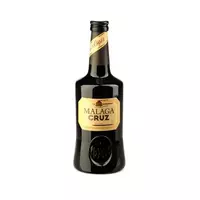Malaga wine

Malaga dessert wine is made from grapes that are grown in a Spanish province called Malaga (in particular in the mountains of the same name and the vicinity of the city). This grape drink can be completely different: to taste this wine is dry, naturally sweet and even like liquor, and its color scheme varies from golden amber shades to almost black. In addition, it is customary to distinguish between young and aged malaga wine by the degree of maturation.
For the production of branded malaga wines, grapes of 2 varieties are used, namely Moscatel and Pedro Jimenez. The ripened grapes intended for making a sweet drink are deliberately left on the bushes to slow down in the sun for several more days, which helps to increase the sugar content of the wort.
For blending, 3 types of wort are used, including gravity, as well as wort of the 1st and 2nd pressures. The first raw material is obtained in special sieves with no mechanical pressure due to the drainage of mature grape juice. The Spaniards call it lagrima, which means "tear. " Another type of wort (the so-called middle) is obtained at the careful pressure of the grapes after the flow of gravity. By squeezing the residual mass, the last type is formed. By the way, fermentation of all 3 types of wort occurs separately and in various ways.
Malaga wine is classified according to various criteria, including: alcohol and sugar content in the finished drink, method of vinification, maturity and color. For example, in terms of alcohol content, malaga wines are divided into natural-sweet (no more than 13%) and liquor type (15-22%). According to the vinification method, they can be natural-sweet, "maestro" wines and "tierno" wines. The latter option involves a very delicate wine obtained from grapes wilted on sunny sites.
Malaga wines ripen in American oak barrels, depending on the length of stay in which they receive names:
Malaga Palibo (up to six months),
Malaga (6-24 months),
Malaga Noble (2-3 years old),
Malaga Anejo (3-5 years old),
Malaga Trasanejo (over 5 years).
In terms of sugar content, this grape drink is usually divided into:
Dry Pale o Pale Dry (no more than 45g/L),
Pale Cream (above 45g/L),
Dulse Crema o Cream (100-140г/л),
Sweet (above 140 g/L).
However, the system of classification of malaga wines by color deserves the most attention, since it clearly indicates some nuances in the creation of such drinks. So, according to this classification, it is customary to distinguish:
Dorado o Golden - golden color dessert wine (there is no syrup in the composition);
Rojo dorado o Rot gold - aged red gold liqueur wine, to which syrup is added (5% of the total drink volume);
Oscuro o Brown - barrel-aged dark (brown) liqueur wine with syrup (5-10%);
Color is a colored malaga wine, when ripened, 10-15% syrup is added;
Negro o Dulkel is a liqueur-aged black wine with a 15% syrup content.
It remains to add a little about the use of malaga wine. Dry brands (seco), chilled to 11-12 ° C, are good as an aperitif, as well as the role of accompanying some snacks. Desserts perfectly combine dessert and liqueur malaga wine, it is also great as a digestif. In addition, this drink can be part of many cocktails and, finally, used in cooking.
It is customary to drink malaga wine from traditional sherry glasses in a slightly chilled form (except dry, which was mentioned above), however, some brands of this wine are served "hot, " that is, at a temperature of about 20 ° C (there is necessarily information on the label of the bottle).
malaga wines 172 kKal
The energy value of malaga wine (Ratio of proteins, fats, carbohydrates - ju):
Proteins: 0.5 g (~ 2 kCal)
Fats: 0 g (~ 0 kCal)
Carbohydrates: 20g (~ 80kCal)
Energy ratio (bj | y): 1% | 0% | 47%
 Español
Español Français
Français Português
Português Русский
Русский 简体中文
简体中文 繁體中文
繁體中文 日本語
日本語 한국어
한국어 العربية
العربية Türkçe
Türkçe Қазақ
Қазақ Deutsch
Deutsch Italiano
Italiano Українська
Українська
